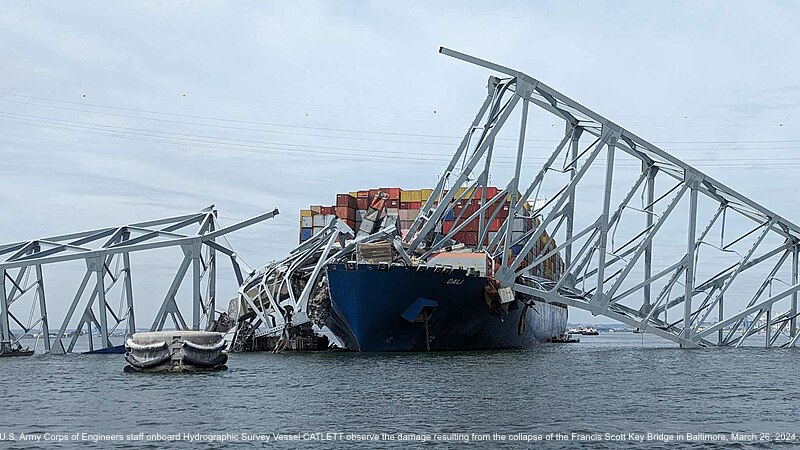| Listen to our audio presentation: History of the United States Constitution |
In the early hours of a calm Tuesday morning, a colossal incident unfolded as the 984-foot Singapore-flagged container ship, Dali, adrift at 9 mph, issued a “mayday” before striking the Francis Scott Key Bridge in Baltimore. The collision resulted in the bridge’s collapse, plunging it into the Patapsco River, and led to the immediate commencement of a search for six construction workers, later presumed dead. The bridge’s destruction has sent ripples of shock and devastation across the East Coast and beyond, affecting traffic, commerce, and the local community deeply.
President Joe Biden has assured federal support for a new bridge, but the timeline remains uncertain. The National Transportation Safety Board (NTSB) is investigating the accident, which appears to be linked to a power loss on the vessel, as confirmed by multiple alarms and propulsion issues reported by the ship’s pilot and assistant. This incident is the second for the Dali, which had a previous collision in 2016.
Authorities and rescue teams, including the U.S. Coast Guard, engaged in extensive search and rescue operations, although hopes of finding survivors diminished with time. The bridge, a vital artery for the region’s transportation and economy, was considered in satisfactory condition before the tragedy. Its collapse not only disrupts daily life but also poses significant challenges for the area’s infrastructure and economic activities.
The Francis Scott Key Bridge, an emblematic structure named after the writer of the national anthem, has been more than just a physical link; it’s a symbol of regional pride and historical significance. Comparisons to the 1980 Tampa Sunshine Skyway collapse, where a similar maritime accident caused significant loss of life and infrastructure, underscore the potential dangers of maritime and infrastructure intersections. The immediate and long-term impacts of this event will likely catalyze discussions on maritime safety, infrastructure resilience, and emergency response, shaping future policies and practices.
Here is a list of some of the worst disasters at sea involving ships:
- MV Doña Paz (1987): The collision between the Philippine passenger ferry MV Doña Paz and the oil tanker MT Vector in the Tablas Strait remains the deadliest peacetime maritime disaster in history, with an estimated 4,386 fatalities.
- MV Sewol (2014): The sinking of the South Korean ferry MV Sewol resulted in the loss of 304 lives, mostly high school students. The disaster was exacerbated by the ship’s illegal modifications and the crew’s poor response.
- SS Sultana (1865): An explosion and sinking of the steamboat SS Sultana on the Mississippi River caused the death of an estimated 1,800 of its 2,400 passengers, making it one of the deadliest maritime disasters in U.S. history.
- RMS Titanic (1912): The sinking of the RMS Titanic after hitting an iceberg is one of the most famous maritime disasters, resulting in the deaths of over 1,500 passengers and crew.
- MV Wilhelm Gustloff (1945): The sinking of the German military transport ship MV Wilhelm Gustloff by a Soviet submarine in the Baltic Sea is one of the deadliest maritime disasters in history, with an estimated 9,400 casualties.
- Eastland Disaster (1915): The capsizing of the SS Eastland in the Chicago River resulted in the deaths of 844 passengers and crew, making it the deadliest shipwreck on the Great Lakes.
- Tasman Bridge Disaster (1975): The bulk ore carrier Lake Illawarra collided with the Tasman Bridge in Hobart, Tasmania, causing a portion of the bridge to collapse and resulting in the deaths of 12 people.
- Queen of the North Disaster (2006): The sinking of the BC Ferries vessel MV Queen of the North after hitting an island off the coast of British Columbia resulted in two fatalities and raised questions about maritime safety and navigation.

